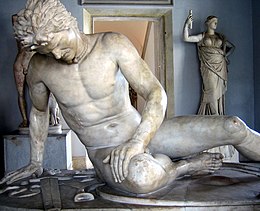
Back غاليون Arabic جاليين ARZ Qallar Azerbaijani گاللار AZB Галы Byelorussian গল (জনগোষ্ঠী) Bengali/Bangla Galianed Breton Gals Catalan Galové Czech Gallier German

The Gauls (Latin: Galli; Ancient Greek: Γαλάται, Galátai) were a group of Celtic peoples of mainland Europe in the Iron Age and the Roman period (roughly 5th century BC to 5th century AD). Their homeland was known as Gaul (Gallia). They spoke Gaulish, a continental Celtic language.
The Gauls emerged around the 5th century BC as bearers of La Tène culture north and west of the Alps. By the 4th century BC, they were spread over much of what is now France, Belgium,[1] Switzerland, Southern Germany, Austria, and the Czech Republic,[1] by virtue of controlling the trade routes along the river systems of the Rhône, Seine, Rhine, and Danube. They reached the peak of their power in the 3rd century BC. During the 4th and 3rd centuries BC, the Gauls expanded into Northern Italy (Cisalpine Gaul), leading to the Roman–Gallic wars, and into the Balkans, leading to war with the Greeks. These latter Gauls eventually settled in Anatolia (contemporary Turkey), becoming known as Galatians.[1]
After the end of the First Punic War, the rising Roman Republic increasingly put pressure on the Gallic sphere of influence. The Battle of Telamon (225 BC) heralded a gradual decline of Gallic power during the 2nd century BC. The Romans eventually conquered Gaul in the Gallic Wars (58–50 BC), making it a Roman province, which brought about the hybrid Gallo-Roman culture.
The Gauls were made up of many tribes (toutās), many of whom built large fortified settlements called oppida (such as Bibracte), and minted their own coins. Gaul was never united under a single ruler or government, but the Gallic tribes were capable of uniting their armies in large-scale military operations, such as those led by Brennus and Vercingetorix. They followed an ancient Celtic religion overseen by druids. The Gauls produced the Coligny calendar.
- ^ a b c "Gaul (ancient region, Europe)". Encyclopædia Britannica Online. Encyclopædia Britannica, Inc. Retrieved 29 November 2012.